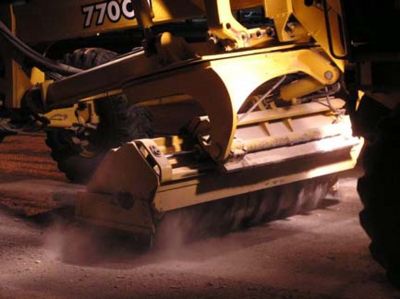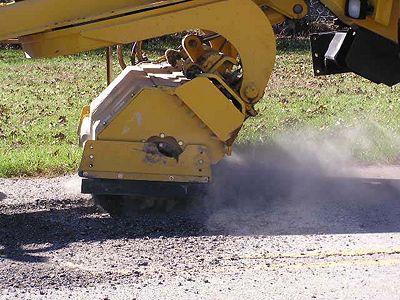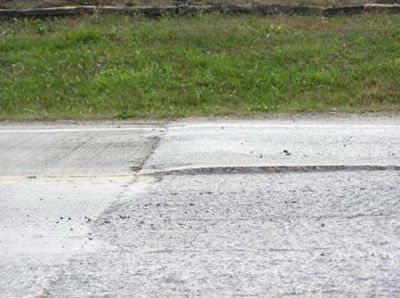Category:622 Pavement and Bridge Surface Removal and Texturing
| Maintenance Planning Guideline for Coldmilling |
| Maintenance Planning Guideline for Coldmilling High Joints |
622.1 Coldmilling Existing Ashaltic Concrete Pavement
Cold milling on asphaltic concrete pavements may be considered on certain projects. Cold milling should be considered but not be limited to the following reasons:
- Remove ruts of 3/8 in. or greater.
- Correct cross slope.
- Improve ride.
- Maintain or increase clearances under structures.
- Maintain gutter depth or curb height.
- Salvage quality aggregates for recycling purposes.
- Remove cracked surface course.
- Restore pavement texture.
- Avoid resurfacing of shoulders.
- Avoid adjustment of manholes or drop inlets.
- Improve asphalt lanes adjacent to PCC lanes.
- Permit uniform thickness and density of resurfacing materials.
- Eliminate need for leveling (wedge) course.
- Conserve mineral aggregates and asphalt plus reduce transportation of materials.
- Improve transitions at beginning and end of project and at bridges.
Milled material is typically recycled by adding liquid asphalt and relaying on supplementary routes, shoulders and outer roadways. All coldmillings should be retained by the contractor. Unless there are unique circumstances, both MoDOT and the contractor benefit from contractor retention of the material. The contractor is made responsible for the removal and proper disposal of the milled material according to Sec 622.
In the exceptional case where the contract establishes district retention of the coldmillings, the district should include the special provision titled "Stockpiling Coldmilled materials (Commission Retained)", JSP-93-07 in the proposal. In this special provision, the designer should list the location for stockpiling the milled material and the approximate round trip distance from the project to the stockpile location. See Processing Reclaimed Asphalt for information on recycling millings from the project. Federal Interstate Maintenance funds may not be used to lay reclaimed material from the project on an interstate outer road or other route that is not part of the interstate system.
Depth of milling should be determined by:
- Average and maximum rut depths.
- Current surface course thickness, obtained through core drilling or data from district or the Construction and Materials Division. The entire surface course should be removed to avoid leaving thin layers of surface course material, which may delaminate or unravel off of the underlying course.
- Required structure clearances.
When snowplowable raised pavement markers (SRPM) are present, they should be noted on the plans for removal by the contractor. See Pavement and Curb Markings - Raised Pavement Markers for more information regarding SRPM removal and replacement.
622.1.1 Maintenance Planning Guideline for Coldmilling
| Code: R314 |
Definition
The time and expenses incurred to maintain pavements not specified elsewhere. Examples include cold-milling and blading aggregate roads. Includes cost of using a mud jack or other equipment to level pavements or fill voids under pavements and bridges approach slabs.
Purpose
To restore rideability or drainage to asphalt or concrete surfaces.
Recommended Equipment
- Cold Mill w/Trailer
- Trucks
- Loader or Power Broom
- Traffic Control Equipment (See Traffic Control for Field Operations)
Recommended Procedure
1. Place traffic control devices as needed. 2. Mill affected area to desired template. 3. Pick up milled material and clean area. 4. Remove traffic control devices.
Safety
Keep clear of equipment. Refer to Safety Policies, Rules & Regulations-Employee Handbook.
Other Considerations
When milling multipatched asphalt area, a sand or cinder seal will lessen the chance of raveling.
References
Standard Specification 622.10.
622.1.2 Maintenance Planning Guideline for Coldmilling High Joints
| Code: R315 |
Definition
The time and expenses incurred for the application of preventative maintenance treatments to pavements.
Purpose
Heating or milling excess material from cracks and joints, and minor profiling to improve rideabiilty.
Scheduling
Schedule during hot weather, normally from March to October, where rotomill is available.
Recommended Equipment
- Motor Grader or Roto-Mill
- Protective Truck
- Heating Torch
- Traffic Control Equipment (See Traffic Control for Field Operations)
Recommended Material
- Sand or Cinders
- Sealing material such as Pavon or Emulsified Asphalt
Recommended Procedure
1. Place traffic control devices as needed.
2. Cut high joint with mill or preheat with torch and trim off excess material with motor grader or by hand.
3. Using stringline or straightedge, check trimmed area. If necessary, repeat step 2 until desired template is obtained.
4. Seal or flycoat surface to encourage a uniform appearance.
5. Remove traffic control devices.
Safety
Keep a watchful eye for traffic. Goggles should be worn in areas where heating is done. Refer to Safety Policies, Rules & Regulations-Employee Handbook.
Other Considerations
A seal coat, cinder, or sand seal will protect affected areas and prevent raveling.
References
Standard Specification 1015.
 |

|
| Roto Grader Milling a Pavement Joint | Roto Grader Operation |
 |
|
| A Completed Milled Pavement Joint |
622.2 Diamond Grinding Existing Portland Cement Concrete Pavement
The diamond grinding operation produces a residue that must be managed in an environmentally responsible manner. The Job Special Provision JSP-06-05 reinforces moDOT and Contractor responsibility and should be used on all diamond grinding or other projects that will produce a slurry residue.
622.2.1 Construction Inspection for Diamond Grinding of Existing Portland Cement Concrete Pavement (Sec 622.30)
MoDOT and MDNR have agreed on the following precautions to prevent the discharge of the slurry from entering waters of the state.
1. No discharge of water/lime slurry will be allowed to enter "waters of the state".
- a. "Waters of the state", all rivers, streams, lakes and other bodies of surface and subsurface water lying within the boundaries of the state which are not entirely confined and located completely upon lands owned, leased or otherwise controlled by a single person or entity.
- b. The Slurry should not be discharged to drainage ways, unvegetated areas or anywhere storm water runoff is likely to occur.
2. Slurry discharges should be stopped at least 25 ft. from any waters of the state where roadway ditch grades are less than 12% or at least 50 ft. where ditch grades are greater than 12% and less than 25%. A minimum of 12 ft. of healthy vegetation must be present to filter slurry residue.
3. On sites where there is sparse or no vegetation to control the movement of the slurry, alternatives that may be used include:
- a. Pump the slurry into tankers and hauled to an area where it can be spread as a lime supplement. This method will require additional tankers and land close to the project site.
- b. Incorporate the slurry into the soil on the right of way next to the road where it will not impact waters of the state, highway or shoulders.
4. The Resident Engineer must approve any other method of application or use of the slurry. The Design Division - Environmental Section should be contacted for guidance on the use of alternative methods.
5. Precautions must be taken at all times to prevent the slurry from entering the waters of the state. Should improper application occur which may result in a discharge of lime slurry to the waters of the state, the contractor shall immediately remove the slurry and notify the Resident Engineer.
See Storm Water Pollution Prevention Plan - Diamond Grinding for more information.
622.2.2 Maintenance Diamond Grinding Existing Portland Cement Concrete Pavement
Diamond grinding is the removal of a thin layer of concrete, generally about 1/4 in., from the surface of the pavement. Three major applications for diamond grinding are to remove surface irregularities, most commonly joint faulting, to restore a smooth-riding surface and to increase pavement surface friction.
The existing pavement should exhibit a uniform cross section and good base. The visible surface distress may include joint and crack faults not exceeding 1/4 in., rut depths less than 1/4 in., moderate to severe polishing and some minor scaling. Diamond grinding is not recommended for pavements with significant slab cracking or severe durability distress such as D-cracking or alkali-silica reactivity. Moreover, the effectiveness of diamond grinding may be limited if significant pumping of loss of support exists, and consideration should be given to the simultaneous application of slab undersealing to prevent the reoccurrence of joint faulting.
Diamond grinding should not be viewed as a one-stop solution to treating concrete pavement surface. Often other repairs such as joint resealing, crack sealing, and pavement undersealing or stabilization should be performed prior to, or in conjunction with the diamond grinding.
In the short term, diamond grinding provides a noticeable smoother riding pavement surface, and improved friction of the pavement. However, the service life of the diamond grinding will depend on traffic loading, existing pavement condition, climate, and concurrent repair or restoration work.